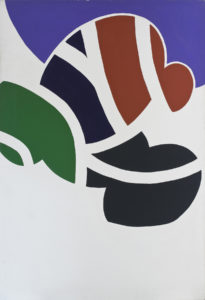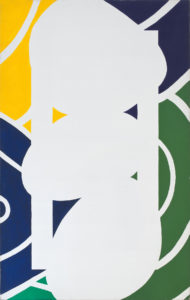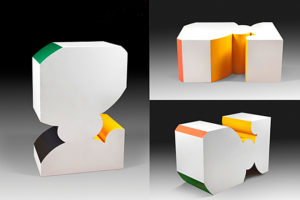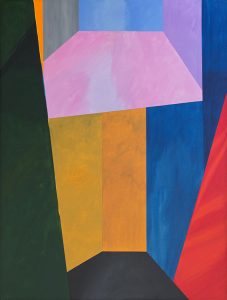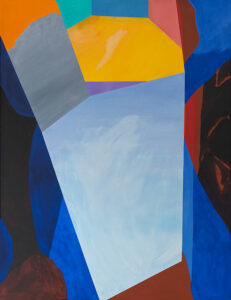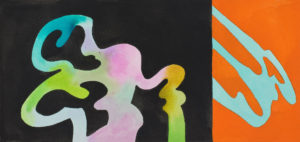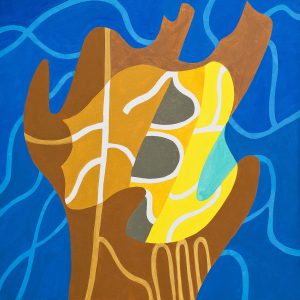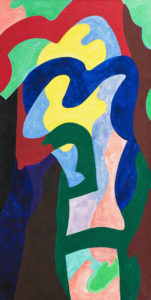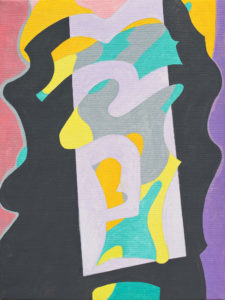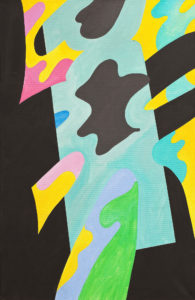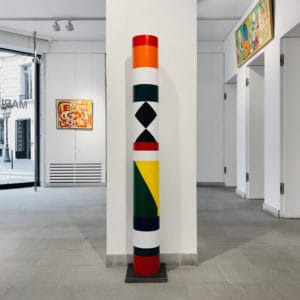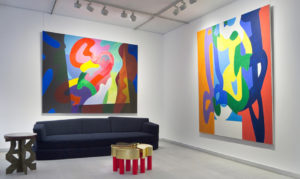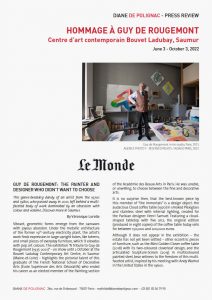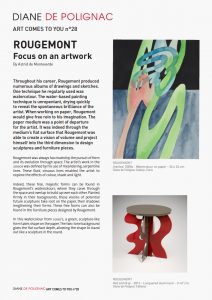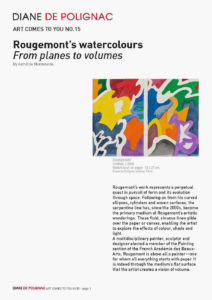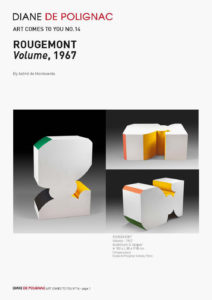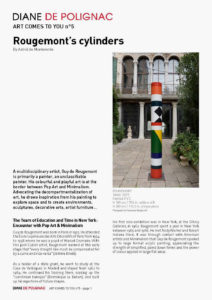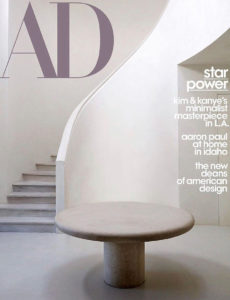
(1935-2021)
A multidisciplinary artist, Guy de Rougemont is primarily a painter, an unclassifiable painter. His colourful and playful art is at the border between Pop Art and Minimalism. Advocating the decompartmentalization of art, he draws inspiration from his painting to explore space and to create environments, sculptures, decorative arts, artist furniture…
Furniture
Exhibitions
Publications
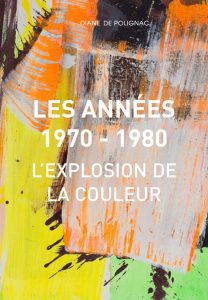
LES ANNÉES 1970 – 1980
L’EXPLOSION DE LA COULEUR
Digital publication – Text by Mathilde Gubanski
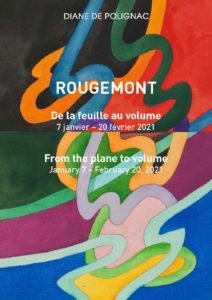
ROUGEMONT
From planes to volumes
Digital publication – Text by Astrid de Monteverde
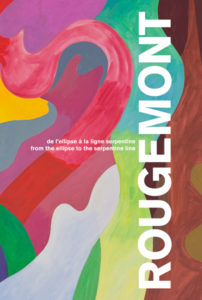
ROUGEMONT
From the ellipse to the serpentine line
Catalog 80 pages – Text by Adrien Goetz
Videos
Virtual visit of the exhibition “Rougemont From the plane to volume”, from January 7 to February 20, 2021.
ROUGEMONT “FROM THE ELLIPSE TO THE SERPENTINE LINE”
Artwork analysis
Press article on Guy de Rougemont in Le Monde by Véronique Lorelle.
September, 2022.
“Rougemont’s watercolours From planes to volumes”, an analysis by Astrid de Monteverde
Rougemont’s Youth and Education
Guy de Rougemont was born in Paris in 1935. Among his ancestors was the General Baron Lejuene, the only battle painter to work under Napoleon I. A child during the Second World War, Rougemont was sent as a refugee to the Haute-Garonne and was educated by correspondence. He was then a boarder in Normandy. At 16 he spent a year in Washington D.C. with his family. His father, an officer, was appointed to work at the Pentagon in the context of the Atlantic Treaty.
Guy de Rougemont then attended the École Supérieure des Arts Décoratifs of Paris from 1954 to 1958 where he was a pupil of Marcel Gromaire. With this post-Cubist artist, Rougemont learned at this early stage that “every straight line must be compensated for by a curve and vice-versa” (Jérôme Bindé).
While he was still a student, Guy de Rougemont participated in the exhibition Découvrir at the Galerie Charpentier in 1955. A year later he entered the Prix Othon Friesz and in 1957, the Prix Fénéon. He then won a state grant to study at the Casa de Velázquez in Madrid and stayed from 1962 to 1964. He continued his education, soaking up the “curvilinear baroque” (Dominique Le Buhan) and built up his repertoire of future shapes. Rougemont met Daniel Alcouffe there, the future director of the Louvre’s decorative arts department, Jean Canavaggio future emeritus professor of Spanish Literature and the artists Jean Degottex, Jean Dupuy and Manuel Viola.
Visit to New York and encounter with American Pop Art and Minimalism
Guy de Rougemont’s first solo exhibition took place across the Atlantic at the D’Arcy Galleries in New York, in 1962. A second solo exhibition was held at the Ateneo Mercantil in Valencia, Spain two years later.
In 1965, Rougemont participated in the Paris Biennale. The same year, he was included in a group exhibition at the Tunnard Gallery of London, and for the first time at the Galerie Flinker in Paris.
The same year, he returned to the USA and spent a year in New York between 1965 and 1966, staying with his friends Jean and Irène Amic. He met Andy Warhol and Robert Indiana there. It was through contact with American artists and Minimalism that Guy de Rougemont opened up to large format acrylic painting, appreciating the strength of simplified, pared down forms and the power of colour applied in large flat areas. In 1966, a second solo exhibition of his work was held in New York, this time at the Byron Gallery. The perpetual secretary of the Institut de France, Arnaud d’Hauterives, underlined a few decades later during the ceremony at which Rougemont was officially received into the Académie des Beaux-Arts: “This period was for you a revelation, you received there a ‘true lesson’ from the great French painters you admire, Léger, Matisse, Bonnard, but seen by a different eye, in other words, purified of all veneer.” Naturally on his return to France, Rougemont assimilated the developments in American painting and the heritage of the great French masters.
The painter Jean Messagier invited Rougemont to exhibit at the Paris Salon de Mai in 1966. The same year, Rougmont made La Tasse (the Cup), a 9-minute film. Three years later, he made a second film, Les Trois Comparses (the Three Stooges) of 10 minutes’ length.
Meeting of Automobile and Painting: Rougemont’s First Experience with an Artistic Environment
In 1967 Gérard Gaveau, a friend of Rougemont who was head of advertising for Fiat cars, asked him to create his first personal artistic environment which was installed in the Fiat space on the Champs-Élysées in Paris. In this unexpected location and with an ephemeral setting, the painter Guy de Rougemont showed his recent large format paintings on canvas. An audacious position to have taken, Rougemont’s art, in the wake of Balla and Italian Futurism here rubbed against automobile design. This “was a first stroke of genius” according to Adrien Goetz: “he installed works among the cars, in majesty, on the Champs-Élysées, a first attempt at placing art in the lives of those passing by, to devoting himself to his love of large spaces, of combining inside and outside.”
And Renée Beslon-Degottex added: “ it was a question of seeing whether, confronted with the perfection of a manufactured object, enjoying the prestige and advantages of sophisticated industrial techniques and the seduction of luxurious materials, the painting, humble in its own material of wood stretcher and raw canvas visible in some areas, poor in its craftsmanship, could still ‘hold up’.”
That year, Guy de Rougemont explored his first polychromatic volumes that are the result of projecting his canvases on a three-dimensional surface. They were exhibited at a solo show at the Galerie Suzy Langlois in Paris the following year.
In Search of a Shape, The Ellipse in Rougemont’s Work
This is when the painter started to work with the ellipse, the first geometrical shape to obsess him. Guy de Rougemont experimented with this elongated circle using vinyl paint on the flat surface of the canvas left untouched in some areas, like the bare skin of the support. The ellipse is also the shape that is found on his first decorative objects: on his free shaped rug produced in 1969 and on his first pieces of furniture, such as the top of his iconic table Cloud Table.
Renaud Faroux wrote “Guy de Rougemont has invented a universe made of cylindrical forms, ellipses, totems, serpentine lines that provide a colourful symbiosis between Minimalism and Pop Art”
Rougemont, an Engaged Artist
The late 1960s were also a time of political activism for the painter Rougemont.
In 1967, he participated in the Salón de Mayo in Havana. The following year, in the midst of the social and popular upheaval of May 1968, the painter, who had mastered screen printing, set up the screen printing studio of the Atelier Populaire at the Paris École des Beaux-Arts with Eric Seydoux. Numerous protest posters were printed there. The same year, he met the painters Eduardo Arroyo, Gilles Aillaud and Francis Biras. After the events of May 1968 and by now installed in his studio in the Marais on the rue des Quatre-Fils, Guy de Rougemont opened a screen printing studio for artists and for political posters.
In connection with the Salon de la Jeune Peinture, Rougemont also participated in working meetings, activist group exhibitions: these were Police et Culture with work on the Presse du Cœur in association with Merri Jolivet (1969) and Journal de la Veuve d’un Mineur (Diary of a Miner’s Widow) (1971).
Guy de Rougemont exhibited regularly at various Salons and art events: at the Salon de la Jeune Peinture (Salon for Young Painting) in Paris (from 1968 to 1971), at the Biennale Internationale de l’Estampe in Paris in 1968 and at the Tokyo Print Biennale in 1969, at the 1970 Salon des Réalités Nouvelles (Salon of New Realities) in Paris, at the Salon Grands et Jeunes d’Aujourd’hui in Paris (from 1975 to 1977), several times at the Salon de Montrouge during the 1980s.
Invited by the art critic Julien Alvard, the painter de Rougemont participated in 1970 in the travelling exhibition Trois Tendances de l’Art Contemporain en France, shown in Belgium at the Mons Musée des Beaux-Arts and then at the Brussels Palais des beaux-arts.
In 1972, an intra-urban solo exhibition was organized for his art at five locations in Le Plessis-Robinson.
From the Ellipse to the Cylinder: A New Shape in Guy de Rougemont’s Work
From 1971, the cylinder became the haunting figure in Rougemont’s work. This round and elongated body, which combines circle and line, became both the new favoured form of his polychrome volumes and his new support for placing colours in space.
The artist confirmed this himself: “The tube came in 1970. Until then my repertoire of shapes was based on the ellipse. The tube is the cylinder – circular in the plane, rectilinear in the elevation – the curve and the straight line are found there fundamentally, and reflections on a cylinder can be elliptical.” The cylinder according to Rougemont, is the magnified version of the industrial tube, the pole, a new reflex in architecture as well.
From then on, the cylinder, which became column, totem, inhabited both public and private spaces. Very quickly it was an emblematic form in the heart of Rougemont’s art.
Set up alone in the urban landscape, like the Totem planted on the place Albert Thomas in Villeurbanne (1981), or conceived in a group of sculptures, like the forests of monumental cylinders raised in the New City of Cergy-Pontoise (1973) and at the Musée de Sculpture en plein air de la Ville de Paris, quai Saint-Bernard, (Interpénétration de Deux Espaces, 1975), the cylinder is decorated with rings and multi-coloured geometrical shapes to sport the artist’s palette for a “sublimation of colour” (Rougemont).
As a “playful geometer”, to use his own phrase, Rougemont, has played with the cylinder’s shape. In Lisbon at the Franco-Portuguese cultural centre, it was a suspended sculpture made of columns hung from the ceiling (Cylindres Stalactites 1985). In Paris, in the entrance hall of the new Saint-Louis hospital the cylinders are grouped in twos and threes (1985), “recalling Yose-Uye, a forestry style in which masters of bonsai practice grouped planting” noted Bernard Chapuis. In Belfort, a municipal fountain presents a forest of cylinders made of marble (1986). In Châteauroux, the cylinders give rhythm to the space at the place de la République (2000).
Beyond the urban space, Rougemont’s cylinders crossed France’s borders and melted into the landscape itself from one end to the other of the planet: from the Open Air Museum in Hakone, Japan (1983) to the Quito Metropolitan Park in Ecuador (1998) and in Santo Tirso, Portugal (2001).
As early as 1976, Rougemont’s first columns were made by Branger-Lajoix of Paris.
During the 1990s, Rougemont reused the cylinder to venture towards the form of the portico: in Munich in front of the Solaris building (1996), at the Hofgarten in Bonn (1997), in Berlin in front of the Portalis building (1998). His monumental sculpture Porte de Riom in the town of that name is a portico treated in a very different way (1987).
More recently, de Rougemont returned to the idea of the cylinder and for the 58th Venice Biennale, designed a new Totem produced by the Galerie Diane de Polignac, Paris. It was put on display in the internal courtyard of the palazzo Contarini-Polignac in October 2019.
The Mise en couleurs du Musée d’Art moderne de Paris, The Perfect Experience of the Cylinder for Guy de Rougemont
The project for the Mise en Couleurs du Portique du Musée d’Art moderne de Paris (Colouring the portico of the Musée d’Art moderne de Paris) in 1974 was for Rougemont the perfect implementation of his experiments with the cylinder. He covered all 20 columns of the museum’s peristyle with coloured sheaths. But this covering didn’t refute the original structure, on the contrary, because the coloured covers didn’t hug the entire shafts, they allowed the building’s skin, its stone sheath, to be glimpsed. In the heart of the French capital and on the threshold of a museum, these coloured poles became Rougemont’s standard for an ephemeral period. Here again, Rougemont’s work is at the frontier of two spaces, between the inside and outside, on the threshold of a museum and already on the street, visible to everyone passing by. Rougemont’s colonnade became a monumental sculpture for a while.
To coincide with this, a catalogue was published with a preface by Bernard Lamarche-Vadel. It also included a conversation between the artists Gilles Aillaud, Eduardo Arroyo, Merri Jolivet, Mathieu and Guy de Rougemont about the Mise en couleurs d’un Musée project. A television report by France-Panorama was also recorded.
In 1975, the Musée d’Art Moderne de Paris bought the sculpture group Huit Grands Tubes sur Socle (Eight Large Tubes on a Base) from the artist Guy de Rougemont.
That year, Rougemont also entered the international competition on the Molino Stucky organized by the Venice Biennale.
At the same time, he met the writer Georges Pérec.
In 1976, an exhibition was devoted to Rougemont at the Secrétariat des Villes Nouvelles in Paris, the organization responsible for building new cities based in Paris. A catalogue entitled Cinq réalisations monumentales was published on this occasion, with a preface by Sabine Fachard.
Guy de Rougemont, from the Cylinder to “Woven Surfaces”
Rougemont pursued his explorations in painting and in 1975 began his work on “woven surfaces” which create relief using colour highlights and light.
The same year, he added colour to Alain Simon’s poem La Fille en Gouache published by Guy Chambelland. Guy de Rougemont returned a few years later to this practice, illustrating with prints the five poems Espejismos by Menene Gras Balaguer. These were printed by Yamamoto and published by Antonio Agra in Barcelona in 1989.
In 1977, he exhibited his first Translucides at the Galerie du Luxembourg in Paris and his large Translucide at the Biennale de la Tapisserie de Lausanne two years later.
He used thermography to make 30 tarpaulins for Art/Espace in Lyon in 1979. These were laid out in the city’s streets.
During the 1980s, Rougemont married the actress Anne-Marie Deschodt, ex-wife of the filmmaker Louis Malle.
In 1982, a monograph on Rougemont was published, titled Rougemont 1962-1982 by Éditions du Regard, in Paris. The text was by Jérôme Bindé.
At the end of the 1980s, several exhibitions were held in Sweden: at the French Institute of Malmö and the Municipal Library of Lomma in 1986, at the Maleu Gallery, in Laudskrona the following year. In 1989, Guy de Rougemont was involved with the exhibition 1789 which was shown in Malmö and Stockholm.
The artist’s work was also shown regularly in Spain, for example at the contemporary art fair ARCO of Madrid in 1990, during a collective organized by the Galería Gamarra y Garrigues.
Rougemont’s Environments: Marrying Art and Architecture, Art and Urbanism
From the 1970s, Guy de Rougemont deployed his inner universe and created environments using the shapes and colours that inhabited him. These commissions, which were both public and private, allowed him to decompartmentalize the artistic disciplines, which was so important to him. This allowed Rougemont to marry artistic creation and architecture, artistic creation and urbanism. During the 1970s, he received several commissions for artistic environments: for the company Baudard-Alvarez of Paris in 1970, for the Agence M.A.O of Paris in 1971 and for the entrance to the offices of real estate company S.E.F.R.I. at the Montparnasse Tower in Paris in 1974…
Rougemont’s art is intended for everyone and is accessible to all.
For Adrien Goetz, “he painted rent controlled accommodation at Vitry in 1974, just like three years earlier he covered the walls of the Rothschild bank staff restaurant. The young Rougemont devoured square metres like an ogre. But as a gentleman passionate about equality. The same treatment for everyone.” With Rougemont, art is democratic and has reached peripheral urban areas such as the Arlequin quarter of Echirolles, a new town in the Grenoble conurbation (mural painting and monumental sculpture created in 1974).
Art also became the perfect reflex for new urbanism projects in the newly created towns. This is the case at Cergy-Pontoise (monumental sculpture at the Croix-Petit school in 1974) and at Marne-la-Vallée (tracery on the floor of the suburban railway station of Noisy-le-Grand-Mont d’Est, in 1976).
With Guy de Rougemont, art invades spaces through renovation work that took on varied forms on a variety of supports. They are painted ceilings: for the Banque Française du Commerce Extérieur (BFCE) in Paris (1980); murals at the police station of Le Cheval Blanc at Nîmes (1992) and at the out-patient hospital at Nanterre (1997); decorative panels, such as in the town hall of Orly Ville (1997); ceramic walls such as at the science university of Amiens (1990) and at the police station of Arpajon (1992); façade decorations in Paris, for example in the 14th arrondissement.
Rougemont’s work also includes large scale equipment: new grandstands at the Auteuil racing course (1978), furniture-sculpture for the renovation of the Plateau Rouher at Creil (1986), lighting along the Via Appia at Albissola in Italy (1986).
“Rougemont likes the idea of being in today’s city, among the cars, meeting people he doesn’t know but who are familiar with his works, even if they don’t know his name. This is what real glory is,” wrote Adrien Goetz.
“I was born in the city, I love the city” claims the artist Rougemont who has such an appreciation for the intrusions of art in the city. And if his urban creations are greeted by a variety of reaction ranging from attraction to rejection, Rougemont’s works never leave people indifferent.
In 1995, Guy de Rougemont also devised the environment for the Foyer of the la Grande Arche at La Défense near Paris and in 1997 he coloured the entrance to the Institut Für Diskrete Mathematik at Bonn, in Germany, using his own colours palette.
Environnement pour une Autoroute by Guy de Rougemont
Among his environments, his flagship project is the Environnement pour une Autoroute (Environment for a Motorway) which stretches along the sides of a 30km section of the A4, the Autoroute de l’Est in France. An original and ambitious project, it was created in a collaboration with the Sopha architectural firm. On this segment of the motorway, a whole forest of polychrome sculptures by Guy de Rougemont gives rhythm to the road landscape: cylinders, spheres, cubes, geometric slabs in the artist’s colours. To coincide with this, a documentary Environnement pour une Autoroute made by Michel Bruzeck was broadcast on TF1.
A winner of several competitions, he was equally awarded the commission to design the entrance hall of the new Saint-Louis hospital in Paris in 1985, as well as the environment for the Salle des Assisses (one of the courtrooms) of the Bobigny courthouse, created in 1986.
Guy de Rougemont on the Ground: the Artist’s Imprint under our Feet
The design of spaces according to Rougemont extends as far as the ground. It consists of markings on the ground itself where paving and tar macadam are combined with artistic creation. Rougemont created many markings. They range from a ministry (the entrance halls of the new finance ministry building at Bercy in Paris (1987)) to a courtroom (the Paris Labour Court in the 10th arrondissement (1991)) to train stations (the spectacular markings on 300m2 of paving at the suburban rail station of Noisy-le-Grand-Mont d’Est in Marne-la-Vallée (1976)), to schools. His designs cover 2,000 m2 at the Educational and Cultural Centre of Sablé (1974), others are at the Vandamme School in the 14th arrondissement of Paris (painted floor and walls, in 1985) and the Sud du Lac School at Saint-Quentin-en-Yvelines (1985).
But Guy de Rougemont’s most spectacular work is probably the design of the paving on the Parvis Bellechasse, the forecourt in front of the Musée d’Orsay: a beautiful mosaic of coloured marble created in 1986. As Adrien Goetz has described it: “In front of the old train station which he saw transformed, he has thought about what a ground decoration should be, the least visible possible and its obliteration by footsteps. He doubtless likes the idea of being ‘at the threshold’ of the institution, on the forecourt, where you pass, your mind filled with memories of paintings and sculptures, when you leave the 19th century.” And the artist added: “My intention was that in the halted time that precedes the movement of each person’s imagination, the movement of their feet should oppose the immobility of the granite and marble of this open air vestibule.”
In 2004, Rougemont returned to this practice, creating his marble marquetry in the entrance of the Hôtel des Mathurins in Paris.
Guy de Rougemont & the Decorative Arts
Very early on, Rougemont was in contact with the decorative arts. His universe is not satisfied with invading space, but also forms the object with the shapes and colours that animate him. As early as 1968, he first worked on porcelain at Limoges. In 1982, Rougemont returned to this support to create new pieces, produced in editions by Artcurial. The artist tried out ceramic with Adriano Bocca and Sandro Soravia while he was staying in Albissola, Italy in 1979. The following year, 900 pieces were made in a set using Rougemont’s colours at Albissola. During the 2000s, Rougemont worked with the Faïencerie de Gien ceramic factory.
Among his projects in the realm of tableware, Guy de Rougemont created platters and table mats for the Galerie Germain in Paris in 1970. He produced silverware with Puiforcat in 1986 and his full cutlery set, Les couverts d’Arlequin, was made in 1992 by the Éditions Lito in Paris.
In 1969, his first rug was made in a free shape. Others were produced: four with Woolmark in 1971, other editions with Artcurial in 1983 (the Transparence rug) and in 1989 (Lumière d’Angle rug) amongst others.
Rougemont also worked with the Manufacture des Gobelins du Mobilier National for the weaving of his Les 7 Piliers de la Sagesse (the 7 Pillars of Wisdom) in 1974. It was displayed at the 1977 Biennale de la Tapisserie de Lausanne. With Saint-Gobain, the artist Guy de Rougemont created his first stained glass window in 1978. It joined the collections of the Musée des Arts Décoratifs in Paris. Ten years later, Rougemont returned to this technique and with Architecture Studio created six windows for the French Embassy at Mascate in Oman (1988).
The artist’s furniture is an excellent illustration of the symbiosis of the arts, forms and colours that Rougemont sought. His Cloud table, created in 1970 for the famous French designer Henri Samuel is iconic and known worldwide. The table top has the free form that he had already used in his paintings. The artist remains above all a painter. “His Cloud Table is famous, to such a point that you could forget that it’s the work of a painter” underlines Adrien Goetz. A second version of this Cloud table on an unused drawing used from 1970 was produced by the Galerie du Passage during the 2000s. Other table-sculptures in varied forms were produced during the 1970s by Henri Samuel. In 1970, Rougemont produced a cloud lamp with the Galerie Germain in Paris.
With Artcurial, several furniture sets were produced during the 1980s: the Mobilier Diderot in 1986 and the Mobilier Du Deffand in 1989, the title of which was a tribute to Madame du Deffant, an 18th century letter writer who, three centuries earlier, had lived and held her literary salon at the location of Rougemont’s studio on the rue des Quatre-Fils.
During the 2010s, Rougemont continued to create artist furniture with the Galerie Diane de Polignac. Several pieces were produced, such as the dining room table Archipelago (2013), the lamp Pop (2014) and the coffee table Golden Clover (2014).
In 1985, the artist Guy de Rougemont was invited to participate at the Salon des Artistes Décorateurs in Paris. There, he exhibited a décor that comprised elements that had previously been used for the set of the television programme Oser on the Antenne 2 channel in Paris.
The 1990s: Retrospectives and Honours for Guy de Rougemont
In 1990, a major Rougemont retrospective was organized at the Musée des Arts Décoratifs in Paris on the theme of public spaces and decorative arts, Espaces Publics et Arts Décoratifs 1965-1990. It highlighted the artist’s pluridisciplinary nature and the extent of his abundant output. Texts by Yvonne Brunehammer, Daniel Marchesseau, Bernard Chapuis and Bernard Minoret were published in the exhibition catalogue.
In 1993, the Arsenal at Metz organized a great retrospective of his work and the following year, two of Châteauroux’s museums showed Guy de Rougemont’s work: at the couvent des Cordeliers and the Musée Bertrand. A text by Bernard Lamarche-Vadel was published for the occasion.
On December 17th 1997, Guy de Rougemont was elected a member of the Painting section of the Académie des Beaux-Arts which is part of the Institut de France, replacing Jean Bertholle. The admission ceremony was held on 26 May 1999. This appointment is a reminder that the colossal and multiform work of Rougemont still remains that of a painter.
With the artist Rougemont, any object, volume, environment, piece of furniture is born from the encounter of a pencil and a piece of paper, and each project is the result of many drawings and a large number of sketches.
“You never pass with impunity from the plane to volume, from the object to the monumental without one day all of it melting together into a single unique practice. I’m a painter: my sculpture, my furniture, my rugs are those of a painter…” emphasized Rougemont.
Whether on canvas or on paper, Rougemont’s work takes on its full dimension, all its force whether in acrylic, watercolour or marker.
In 1998, a new exhibition was held at the Musée Paul Valéry in Sète. For that occasion, Henry Périer published the text La Couleur en Trois Dimensions (Colours in three dimensions).
In the late 1990s, the Galerie Maeght held two exhibitions on Guy de Rougemont: one in Paris in 1998 for which a travelling journal was published, with texts by Antoine de Tovar, Eduardo Arroyo, Jean Cortot, and Marco del Re; another exhibition was organized at the Galerie Maeght of Barcelona, in 1999.
Guy de Rougemont & the Serpentine Line
Starting in the early 2000s, Rougemont opted for the serpentine line as a new means of expression. He returned to the curve that he loves so much because “it brings together” as he claims.
Rougemont then created a series of monumental sculptures that rose and flourished in the four corners of the world, visible to all: at Ordino in the principality of Andorra (l’Homme de Fer (Iron Man), 2003) in Taiwan in the park of the Chiang Kai-shek Residence (Ombre Chinoise (Chinese Shadow), 2003) in Porto Rico at the Mayagues university (Serpentinata Caraaïbe).
The artist returned to this idea of art accessible to all. “With a few others, Rougemont dreams of art owned by all, freely accessible, natural and belonging as little or as much to everyone as do the trees of a forest, a pebble picked up on the sand or the rocks on the seashore.” wrote Renée Beslon-Degottex.
Many monumental sculptures with a serpentine line were also commissioned for private collections in Dubai, Marrakech, Majorca…
This serpentine line was put in the spotlight during a series of exhibitions in the south of France in 2004: at the Chapelle des Jésuites in Nîmes, at the Carré Sainte-Anne in Montpellier, at the Chapelle des Capucins in Aigues.
In 2010, it was in the bar of New York’s Mark Hotel that Rougemont laid out his serpentine line, in a project developed by the interior designer Jacques Grange.
The same year, Guy de Rougemont created a polychrome marble sculpture for the Hôtel Burgundy in Paris, installed in the winter garden, as well as a design on the floor of the entrance hall.
In 2011, Rougemont worked with the Château Mouton Rothschild winery to colour the pillars of the Museum of Wine in Art at Mouton, housed in a former barrel warehouse. The artist also illustrated the label for the 2011 vintage, following a tradition the winery had started in 1945, following in the footsteps of Cocteau, Dalí, César, Picasso, Warhol …
In 2013, a solo exhibition was devoted to him at the PAD Tuileries fair in Paris. In 2019 the exhibition De l’ellipse à la ligne serpentine at the Galerie Diane de Polignac in Paris put his large format paintings of the 2000s in the spotlight. For the occasion, a text by Adrien Goetz was published in the exhibition catalogue.
The painter Guy de Rougemont lives between his Paris studio in the 14th arrondissement and one in Marsillargues in the south of France. The light of the South continues to inspire the artist’s palette and shapes.
“Rougemont is an unusual case. He is an eclectic artist who constantly seeks to renew the means of his expression” as his great friend Eduardo Arroyo has expressed so well.
Rougemont passed away on August 19th, 2021 in Montpellier, France.
© Diane de Polignac Gallery / Astrid de Monteverde
Translation: Jane Mac Avock
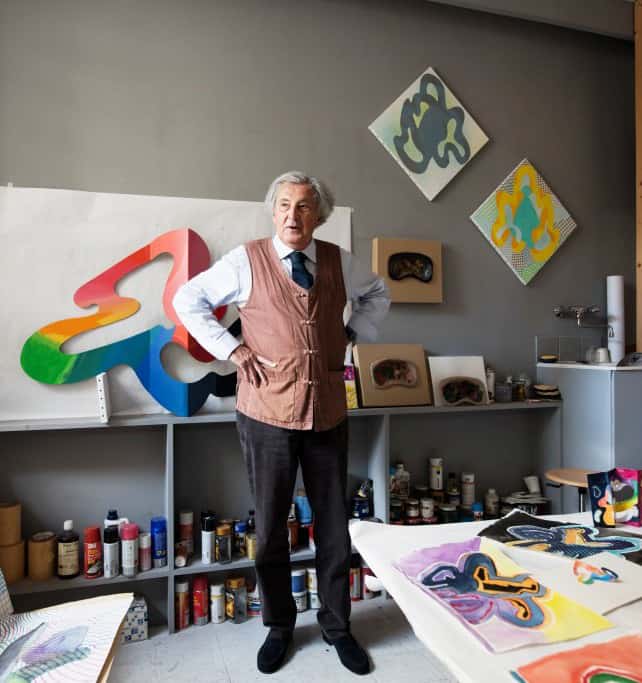
SELECTED COLLECTIONS
Selected collections
Arles, Musée Réattu
Paris, Musée d’Art Moderne de Paris
Paris, Musée des Arts Décoratifs
Paris, Centre National Des Arts Plastiques
Paris, Musée de Sculpture en Plein Air de la Ville de Paris
Paris, Atelier des Gobelins, Mobilier National
Saint-Étienne Métropole, Musée d’Art Moderne et Contemporain
Santiago de Chile, Museo de la Solidaridad Salvador Allende
Sélestat, Fond Régional d’Art Contemporain FRAC Alsace
SELECTED WORKS IN PUBLIC SPACES
Selected works in public spaces
Mural, staff restaurant, Banque Rothschild, Paris; Michel Boyer decorator, 1970
Environment for the Agence Baudard-Alvarez, Paris, 1970
Environment for the Agence M.A.O., Paris, 1971
Environment the offices of M.D.F., Rungis, 1972
Environment for the entrance hall of the offices of S.E.F.R.I., Tour Montparnasse, Paris, 1974
Monumental sculpture, Groupe Scolaire de Croix-Petit, Cergy-Pontoise; Lévy architect, 1974
Colour Scheem, H.L.M (rent controlled housing), Vitry, François Girard architect, 1974
Monumental sculpture and colouring of a street in Échirolles, Villeneuve de Grenoble, A.U.A. architects, 1974
Environment for the corridors of a residence in Neuilly-sur-Seine; Michel Boyer decorator, 1974
Colouring of elevator cabins, Société Otis, 1974
Floor design, area 2,000 m2, Centre Éducatif et Culturel, Sablé (Sarthe); A.R.C. architects, 1974
Mise en Couleurs du Portique du Musée d’Art moderne de Paris (Colouring the portico of the Musée d’Art moderne de Paris – temporary installation), Paris, 1974
Monumental sculpture, Musée de Sculptures en plein air de la Ville de Paris, quai Saint-Bernard, Paris, 1975
Floor design, area 300 m2, Gare du RER (suburban railway) at Noisy-le-Grand-Mont d’Est, Marne-la-Vallée; Zublena architect, 1976
Environnement pour une autoroute, Autoroute de l’Est A4 for a 30 km stretch; Sopha architects, 1977
Environment for the new grandstand, Auteuil racecourse, 1978
4 painted ceilings for the B.F.C.E.; Martine Dufour decorator, 1978
Monumental sculpture, Lycée Professeur Dargent, Lyon, 1980
Environnement pour le Lycée Hôtelier de Tain-l’Hermitage; Martine Dufour decorator and Biny architect, 1981
Design of the Place Albert-Thomas, Villeurbanne, 1981
Monumental sculpture, Montbéliard, 1981
Monumental sculpture, Hakone Open Air Museum, Japon, 1983
Monumental sculpture, Embassy of France, Washington D.C., 1984
Monumental sculpture, Romans-sur-Isère, 1984
Environment (design of the floor and murals for the vestibule), Groupe Scolaire Vandamme, Paris 14ème; Jean-Claude Bernard architect, 1985
Design of the entrance hall of the new Saint-Louis hospital; Badani, Roux-Dorlut, Metulesco architects, 1985
Hanging Sculpture, Institut Franco-Portugais de Lisbonne; Jean-Pierre Buffi architect, 1985
Floor pattern, Groupe scolaire Sud du Lac, Saint-Quentin-en Yvelines; Jean-Claude Bernard architect, 1985
Design of the ground, Parvis Bellechasse, Musée d’Orsay; Bardon, Colboc, Filippon architects, 1986
Furniture-Sculpture, Plateau Rouher, Creil (Oise), 1986
Monumental fountain, City of Belfort, 1986
Design of the lighting equipment along the Via Appia at Albissola, 1986
Environment for the Salle des Assises, Bobigny courthouse; ETRA architects, 1986
Porte de Riom, monumental sculpture, Riom, 1987
Design for the floor in the entrance hall of the new finance ministry, Bercy, Paris; Chemetov and Huidobro architects, 1987
Large sculpture, Montblanc headquarters, Hamburg, 1987
Anamorphoses, polychrome sculptures, Centre Chueller, Clichy, 1987
Colonne des droits de l’homme (Column of the Rights of Man), monumental sculpture, La Villette, (Jean Hamon Collection), 1988
Six horizontal stained glass windows, Embassy of France, Mascate, Oman; Architecture Studio, 1988
Fontaine de Gerland, Lyon, 1989
Monumental sculpture, Manheimmer Hamburg Cie (entrance hall), Hamburg, 1989
Environment for a building entrance, rue Blanche, Paris, 1989
Fountain at Gennevilliers for Europarc, 1990
Ceramic wall, Science faculty, Amiens, 1990
Floor design, building entrance, Quai Louis Blériot, Paris, 1990
Monumental sculpture, Oloron-Sainte-Marie (Béarn), 1991
Floor pattern, Labour court, Paris 10ème, 1991
Monumental sculpture, Lycée Bezout, Nemours, 1992
Ceramic wall, police station, Arpajon, 1992
Mural, Hôtel du Cheval-Blanc, Nîmes, 1992
Design of a building facade, Paris 14ème, 1992
Environment for an “internal street” and colour scheme, school at Magnaville, Mantes-la-Jolie, 1993 and 1995
Environment, Entrance area to the Grande Arche, Paris, La Défense, 1995
Colour scheme, school at Magnanville (second phase), Mantes-la-Jolie.
Monumental sculpture, in front of the Solaris building, Munich, 1996
Marble marquetry flooring, Santiago de Chili, 1997
Ironwork on the ground floor of a building, quai de Seine, Paris, 1997
Mural of 300 m, out-patient hospital, Nanterre, 1997
Decorative panel, Marie d’Orly Ville (wedding hall), 1997
Colour scheme in the entrance of the Institut Für Diskrete Mathematik, Bonn, Germany, 1997
Monumental sculpture, Hofgarten, University of Bonn, Germany, 1997
Monumental sculpture, Quito Metropolitan Park, Ecuador, 1998
Monumental sculpture, Puyo, South Korea, 1999
Monumental sculpture, Châteauroux, 2000
Monumental sculpture, Santo Tirso, Portugal, 2001
Quartier Marengo, Toulouse, 2002
L’homme de fer (Iron Man), monumental sculpture, Ordino, Principality of Andorra, 2003
Ombre chinoise (Chinese Shadow), monumental sculpture, Park of the Chiang Kai-shek Residence, Taiwan, 2003
Floor, marble marquetry, entrance of the Hôtel des Mathurins, Paris, 2004
Serpentinata Caraaïbe, monumental sculpture, Mayagues university, Porto-Rico, 2004
Furniture, Mark Hotel, New York, 2010
Polychrome marble sculpture & floor design for the entrance hall, Hôtel Burgundy, Paris, 2010
SELECTED EXHIBITIONS
Selected exhibitions
D’Arcy Galleries, New York, 1962
Ateneo Mercantil, Valencia, 1964
Tunnard Gallery, London, 1965
Galerie Karl Flinker, Paris, 1965, 1980
Byron Gallery, New York, 1966
Salon de Mai, Paris, 1966
Solo exhibition, Hall FIAT, Paris, 1967
Salon de Mai, Havana, 1967
Salon de la Jeune Peinture, Paris, 1968, 1969, 1970, 1971
Biennale Internationale de l’Estampe, Paris, 1968
Galerie Suzy Langlois, Paris, 1969
Tokyo Print Biennale, 1969
Salon des Réalités Nouvelles, Paris, 1970
Trois tendances de l’art contemporain en France, Musée des Beaux-Arts, Mons and Palais des Beaux-Arts, Brussels, 1970
Solo exhibition, Galerie Germain, Paris, 1971
Centre Culturel de Villeparisis, 1971
Intra-urban solo exhibition, Plessis-Robinson, 1972
Château de Breteuil, Choisel, 1972
Solo exhibitions, Galerie du Luxembourg, Paris, 1973, 1975, 1977
Galerie 21, Saint-Etienne, 1973
Mittelrhein Museum, Koblentz, R.F.A., 1973
Solo exhibition, Galerie Cupillard, Grenoble, 1974, 1983
Rougemont, Musée d’Art Moderne de la Ville de Paris, 1974
Rétrospective 1966-1975, Maison de la Culture de Chalon-sur-Saône, CRACAP, 1975
Solo exhibition, Galerie Harry Jancovici, Paris, 1976
Salon Grands et Jeunes d’Aujourd’hui, Paris, 1975, 1976, 1977
Biennale de la Tapisserie de Lausanne, 1977, 1979
Solo exhibition, Galerie Anne van Horenbeeck, Brussels, 1978
Retrospective, Grand Orient de France, Paris, 1978
Solo exhibition, Centre Culturel du Plessis-Robinson, 1979
Encrage-Passage, Galerie Le Dessin, Paris, 1979
Salon de Montrouge, 1980, 1981, 1982, 1983, 1987
Solo exhibition, Centre Culturel de Montbéliard, 1982
Solo exhibition, Artcurial, Paris, 1982, 1996
Solo exhibition, Galerie du 7, rue Princesse, Paris, 1983
Solo exhibition, Galerie de l’Ancienne Poste, Montluçon, 1984
Solo exhibition, town hall, Villeurbanne, 1984
Solo exhibition, Galleria Ganzerli, Naples, 1984
Solo exhibition, Galerie Piranesi, Zürich, 1984
Solo exhibition, Musée de Romans-sur-Isère, 1984
Galerie Cupillard, Saint-Tropez, 1984
Solo exhibition, Façade Gallery, New York, 1985
Salon des Artistes Décorateurs, 1985
Dissonnances, Arles, 1985
Le Méjan, Arles, 1986
Exhibition, French institute of Malmö and municipal library of Lomma, Sweden, 1986
Solo exhibition Interventions urbaines, château of Villemonteix (Creuse), 1986
Solo exhibitions, Galerie Pascal Gabert, Paris, 1987, 1992, 2005, 2007
Solo exhibition, Musée Mandet, Riom, 1987
Solo exhibition, Galerie Maleu, Laudskrona, Sweden, 1987
Solo exhibitions, Galerie Gamarra y Garrigues, Madrid, 1988, 1989 (FIAC), 1990 (ARCO collective)
Galerie Thomas Levy, Hamburg, 1989 (group exhibition), 1990
Solo exhibition, Galerie ASB, Barcelona, 1989
Solo exhibition, Galerie Levy-Dahan, Paris, 1989
Sculptures, Galerie Lévy, Madrid, 1989
Retrospective Rougemont, Espaces publics et Arts Décoratifs 1965-1990, Musée des Arts Décoratifs, Paris, 1990
Solo exhibition, Galerie Stemmle Adler, Heidelberg, Germany, 1992
Solo exhibition, Galerie Wunderhaus, Munich, 1992
Retrospective, L’Arsenal, Metz, 1993
Solo exhibitions, Réunion des Musées du Mans, 1993
Galería de Arte Diners, Bogota, Colombia, 1993
Solo exhibition, town hall of the 8ème arrondissement, Paris, 1994
Galerie Claude Lemand, Paris, 1994
Retrospective, Les Cordeliers and Musée Bertrand, Châteauroux, 1994
Solo exhibition, Restaurant Tantris, Munich, 1997
Solo exhibition, Musée Paul Valéry, Sète, 1998
Rougemont, Parcours récent, Galerie Maeght, Paris, 1998
Solo exhibition, Galerie Maeght, Barcelona, 1999
Solo exhibition, Château de Tarascon, Tarascon-en-Provence, 1999
Solo exhibition, Château de Lavérune (Hérault), 2000
Galerie Fabrice Galvani, Toulouse, 2000
Solo exhibition Ellipse et cylindre, Volumes Polychromes, Galerie du Passage, Paris, 2003
Solo exhibition, Galerie Franck Font, Montpellier, 2003
Solo exhibition, Galerie Jyff, Montpellier, 2003
Solo exhibition La Linea Serpentina, Chapelle des Jésuites, Nîmes, 2004
Solo exhibition, Centre des Arts, Enghien les Bains, 2004
Solo exhibition, Carré Sainte Anne, Montpellier, 2004
Rougemont 2000-2004, Chapelle des Capucins, Aigues-Mortes, 2005
Solo exhibition, El Almudín exhibition space, Valencia, 2005
Rougemont, Tableaux et Sculptures 2004-2006, Art Paris, Galerie Pascal Gabert, 2007
Solo exhibition Serpentines 2000-2010, Galerie du Passage, Paris, 2010
Solo exhibition, Château Mouton Rothschild, Pauillac, 2011
Rougemont, Lumières, Galerie Detais, Paris, 2012
Rougemont à Florac, town of Florac (Lozère), 2012
Retrospective, Pavillon des Arts et du Design (PAD) Tuileries, Paris, Galerie Diane de Polignac, 2013
Solo exhibition, Pour Répondre au Commencement, Galerie du Passage, Paris, 2017
Solo exhibition, Agence A+Architecture, Montpellier, 2018
Rougemont, De l’Ellipse à la Ligne Serpentine, Galerie Diane de Polignac, Paris and Galerie Aliénor Prouvost, Brussels, 2019
SELECTED BIBLIOGRAPHY
Selected bibliography
Manuel Viola (text), Rougemont, exhibition catalogue, Ateneo, Valencia, Spain, 1964
Guy de Rougemont (text), Rencontre de l’Automobile et de la Peinture, exhibition Hall Fiat, Paris, 1967
Marie-Odile Briot (text), Rougemont, exhibition, Centre Culturel de Villeparisis, 1970
Renée Beslon-Degottex, Marie-Odile Briot, Françoise Thieck, Rougemont, 1955-1972, monograph, Paris, Baudard-Alvarez publisher, 1973
Bernard Lamarche-Vadel (text), Eduardo Arroyo, Gilles Aillaud, Merri Jolivet, Mathieu and Guy de Rougemont, Rougemont 1972-1974, Galerie du Luxembourg, Paris, Baudard Alvarez publishers, to coincide with the exhibition at exhibition the Musée d’Art Moderne de la Ville de Paris, ARC 2, 1974
Daniel Meiller, Patrick Le Nouëne, Rougemont, exhibition catalogue, Maison de la Culture de Châlon-sur-Saône, 1975
Anne Tronche, major review in Opus, 1975
Giovanni Joppolo, article Dans l’Espace en Mouvance du Voyage in Opus, 1978
Sabine Fachard (text), Cinq réalisations monumentales, exhibition catalogue, Paris, Secrétariats des Villes Nouvelles publisher, 1976
Pierre Alain Jolivet (text), Rougemont, exhibition catalogue, Paris, Grand Orient de France, 1978
Gérard-Georges Lemaire (text), Lambeaux, fragments, non-finito…, exhibition catalogue, Paris, Galerie Karl Flinker, 1980
Jérôme Bindé (text), Rougemont, exhibition catalogue, Centre d’Action Culturelle, Montbéliard, 1982
Jérôme Bindé (text), Rougemont 1962-1982, monograph, Paris, Éditions du Regard, 1982
Ghislaine Durant (text), Découper pour Voir, exhibition catalogue, Paris, Galerie du 7, 1983
Gérard-Georges Lemaire (text), Charles Hernu (preface), Rougemont, Géométries Mentales, exhibition catalogue, Hôtel de Ville de Villeurbanne, 1984
Daniel Alcouffe and Guy de Rougemont (text), A Diderot, Paris, Artcurial publisher, 1986
Christian Derouet (text), Rougemont, Lumières et Autres Travaux 1983-1987, exhibition catalogue, Paris, Galerie Pascal Gabert éditeur, 1987
Eduardo Arroyo (text), Rougemont, exhibition catalogue, Madrid, Galería Gamarra y Garrigues, 1988
Bernard Minoret (text), Secrétaire Du Deffand, Paris, Artcurial publisher, 1989
Menene Gras Balaguer (text), Rougemont, exhibition catalogue, Barcelona, Galerie ASB, 1989
Yvonne Brunehammer, Daniel Marchesseau, Bernard Chapuis, Bernard Minoret, Guy de Rougemont, Rougemont: Espaces Publics et Arts Décoratifs 1965-1990, Musée des Arts décoratifs exhibition catalogue, Paris, Union des Arts décoratifs, 1990
Bernard D. Constant (text), Rougemont, Hamburg, Galerie Levy, 1990
Menene Gras Balaguer (text), Rougemont, Altérations 1991-1992, Paris, Éditions Fragments, 1992
Gérald Gassiot-Talabot (text), Serge Nikitine (preface), Rougemont, Réunion des Musées du Mans, 1993
Bernard Lamarche-Vadel (text), Rougemont, rétrospective, exhibition catalogue, Châteauroux, Cordeliers and Musée Bertrand, 1994
Guy de Rougemont (text), Rougemont, dans l’Espace de la Couleur, Paris, Artcurial publisher, 1996
Henry Périer (text), exhibition catalogue, Sète, Musée Paul Valéry, 1998
Antoine de Tovar, Eduardo Arroyo, Jean Cortot, Marco Del Re (texts), Rougemont, Parcours Récent, Carnet De Voyage, Paris, Maeght publisher, 1998
Renée Beslon-Degottex, Dominique Le Buhan (texts), Rougemont, Ellipse et Cylindre, Volumes Polychromes, 1965-1975, Paris, Galerie du Passage, 2003
Vincent Bioulès (preface), Rougemont 2000-2004, Chapelle des Capucins (Aigues-Mortes) exhibition catalogue, Paris, FVW Éditions, 2004
Manuel Viola, Gérard Xuriguera (text), El Almudín (Valencia) exhibition catalogue, Paris, FVW Éditions, 2004
Adrien Goetz (text), Rougemont, De l’ellipse à la ligne serpentine, exhibition catalogue, Paris, Galerie Diane de Polignac and Brussels, Galerie Aliénor Prouvost, 2019
Gay Gassmann, Inside Legendary Creator Guy de Rougemont’s Unassuming Compound in the South of France, article in AD US, March 2020
BOOK ILLUSTRATIONS
Book illustrations
Alain Simon (poeme), La fille en gouache, Éditions Guy Chambelland, 32 screenprints by Rougemont, Michel Caza studio, 1975
Menene Gras Balaguer Espejismos (5 poems), 5 prints by Rougemont printed by Yamamoto, Barcelona, Antonio Agra publisher, 1989
Xavier Bordes (text), Levées d’Ombre et de Lumière, 22 lithographs by Rougemont, Atelier Grapholith, Paris, Éditions Les Cent Une, 1992
FILMOGRAPHY
Filmography
Michèle Arnaud, Jean Pourtalé, Mise en Couleurs d’un Musée (Colouring a Museum), film shown to date, 1974 & T.V. report France-Panorama
Michel Bruzeck, Environnement pour une autoroute, TF1, 1977
Michel Lancelot, Rougemont, directed by Georges Paumier, Antenne 2, 1979
Jean Dupuy, Artist Propaganda, Centre Pompidou, 1977-1978
Portraits d’Artistes: Rougemont, T.V. film directed by Thorn-Petit, RTL, 1983
Rougemont, Objectif Lune (Rougemont, direction the Moon), directed by Christian Zabatura, 1995-1997
Guy de Rougemont Faq
On the GUY DE ROUGEMONT FAQ page, find all the questions and answers dedicated to the modern art painter Guy de Rougemont.
